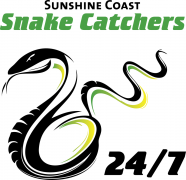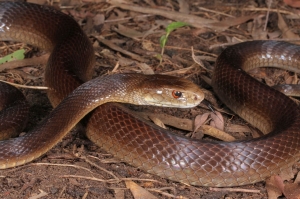Significance to Humans:
High-Venomous
Bites from this species have caused human fatalities. A nervous, ready biter it will defend itself with multiple strikes if threatened. Often referred to as Australia’s most dangerous snake. Bites from this species should be treated immediately and attended to with correct first aid.
General description:
Head long with distinct angular brow. Snout and face generally paler than body colour, otherwise uniform colouring along upper body ranging from pale brown to almost black. Belly cream with orange spots and blotches. Midbody scale rows at 21-25 rows.
Average Length:
Average up to 2 metres, but although rare, individuals have been recorded to nearly 3 metres in total length.
Habitat in SE Qld:
Dry open forest, grassy woodlands and cane-fields.
General habits:
Mostly active during the day, especially warm and hot mornings. Also recorded active on roads at night. A very secretive and highly alert snake that is rarely seen even in areas where they are apparently common.
Diet:
Specialises in mammals like mice, rats and bandicoots.
Local distribution:
The Taipan is uncommonly sighted throughout the Sunshine Coast region with the majority of records within the last 30 years being of road killed specimens. Does not occur in built up suburbs of the Sunshine Coast. live specimans known from Tinbeerwah, Tewantin and Cooroy. Sightings seem to be contained to the outer Northern Suburbs of the Sunshine Coast.
Around the home:
The discovery of a Taipan around the home would be considered an extremely rare occurrence within the Sunshine Coast.

